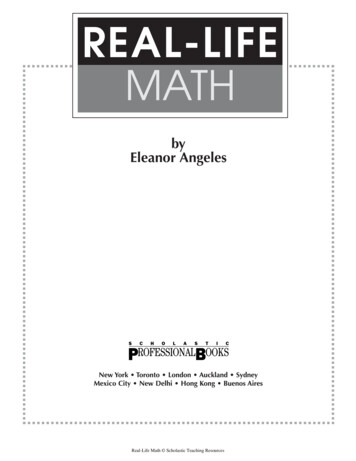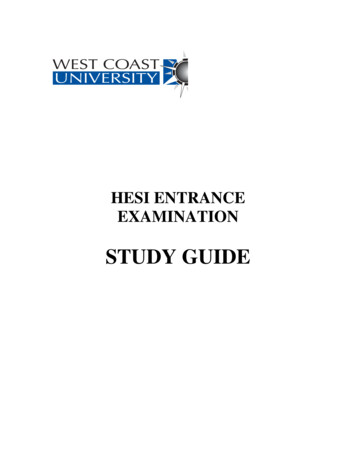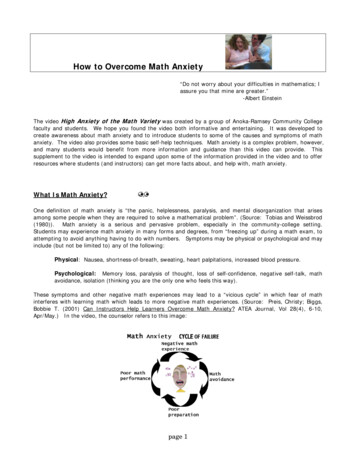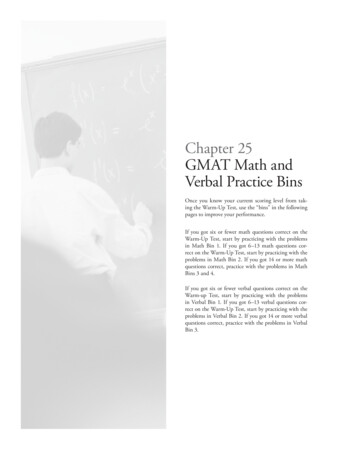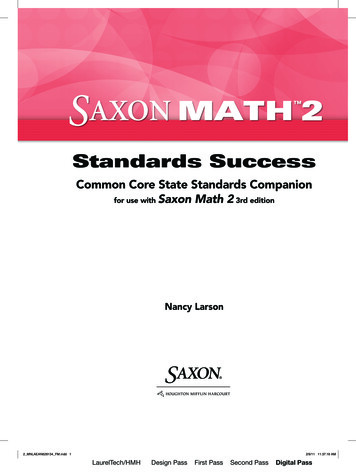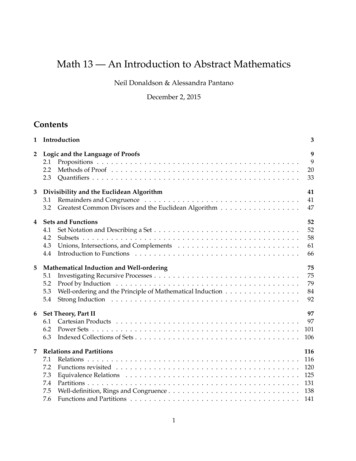
Transcription
Math 13 — An Introduction to Abstract MathematicsNeil Donaldson & Alessandra PantanoDecember 2, 2015Contents1Introduction2Logic and the Language of Proofs2.1 Propositions . . . . . . . . . . . . . . . . . . . . . . . . . . . . . . . . . . . . . . . . . . .2.2 Methods of Proof . . . . . . . . . . . . . . . . . . . . . . . . . . . . . . . . . . . . . . . .2.3 Quantifiers . . . . . . . . . . . . . . . . . . . . . . . . . . . . . . . . . . . . . . . . . . . .9920333Divisibility and the Euclidean Algorithm3.1 Remainders and Congruence . . . . . . . . . . . . . . . . . . . . . . . . . . . . . . . . .3.2 Greatest Common Divisors and the Euclidean Algorithm . . . . . . . . . . . . . . . . .4141474Sets and Functions4.1 Set Notation and Describing a Set . . . . .4.2 Subsets . . . . . . . . . . . . . . . . . . . .4.3 Unions, Intersections, and Complements4.4 Introduction to Functions . . . . . . . . .5252586166.757579849253.Mathematical Induction and Well-ordering5.1 Investigating Recursive Processes . . . . . . . . . . . . . . .5.2 Proof by Induction . . . . . . . . . . . . . . . . . . . . . . .5.3 Well-ordering and the Principle of Mathematical Induction5.4 Strong Induction . . . . . . . . . . . . . . . . . . . . . . . .6Set Theory, Part II976.1 Cartesian Products . . . . . . . . . . . . . . . . . . . . . . . . . . . . . . . . . . . . . . . 976.2 Power Sets . . . . . . . . . . . . . . . . . . . . . . . . . . . . . . . . . . . . . . . . . . . . 1016.3 Indexed Collections of Sets . . . . . . . . . . . . . . . . . . . . . . . . . . . . . . . . . . . 1067Relations and Partitions7.1 Relations . . . . . . . . . . . . . . . . . .7.2 Functions revisited . . . . . . . . . . . .7.3 Equivalence Relations . . . . . . . . . .7.4 Partitions . . . . . . . . . . . . . . . . . .7.5 Well-definition, Rings and Congruence .7.6 Functions and Partitions . . . . . . . . .1.116116120125131138141
8Cardinalities of Infinite Sets1468.1 Cantor’s Notion of Cardinality . . . . . . . . . . . . . . . . . . . . . . . . . . . . . . . . 1468.2 Uncountable Sets . . . . . . . . . . . . . . . . . . . . . . . . . . . . . . . . . . . . . . . . 153Useful Texts Book of Proof, Richard Hammack, 2nd ed 2013. Available free online! Very good on the basics: ifyou’re having trouble with reading set notation or how to construct a proof, this book’s for you!These notes are deliberately pitched at a high level relative to this textbook to provide contrast. Mathematical Reasoning, Ted Sundstrom, 2nd ed 2014. Available free online! Excellent resource.If you would like to buy the actual book, you can purchase it on Amazon at a really cheap price. Mathematical Proofs: A Transition to Advanced Mathematics, Chartrand/Polimeni/Zhang, 3rd Ed2013, Pearson. The most recent course text. Has many, many exercises; the first half is fairlystraightforward while the second half is much more complex and dauntingly detailed. The Elements of Advanced Mathematics, Steven G. Krantz, 2nd ed 2002, Chapman & Hall andFoundations of Higher Mathematics, Peter Fletcher and C. Wayne Patty, 3th ed 2000, Brooks–Coleare old course textbooks for Math 13. Both are readable and concise with good exercises.Learning Outcomes1. Developing the skills necessary to read and practice abstract mathematics.2. Understanding the concept of proof, and becoming acquainted with several proof techniques.3. Learning what sort of questions mathematicians ask, what excites them, and what they arelooking for.4. Introducing upper-division mathematics by giving a taste of what is covered in several areas ofthe subject.Along the way you will learn new techniques and concepts. For example:Number Theory Five people each take the same number of candies from a jar. Then a group ofseven does the same. The, now empty, jar originally contained 239 candies. Can you decidehow much candy each person took?Geometry and Topology How can we visualize and compute with objects like the Mobius strip?Fractals How to use sequences of sets to produce objects that appear the same at all scales.To Infinity and Beyond! Why are some infinities greater than others?
1IntroductionWhat is Mathematics?For many students this course is a game-changer. A crucial part of the course is the acceptance thatupper-division mathematics is very different from what is presented at grade-school and in the calculus sequence. Some students will resist this fact and spend much of the term progressing throughthe various stages of grief (denial, anger, bargaining, depression, acceptance) as they discover thatwhat they thought they excelled at isn’t really what the subject is about. Thus we should start at thebeginning, with an attempt to place the mathematics you’ve learned within the greater context of thesubject.The original Greek meaning of the word mathemata is the supremely unhelpful, “That which is tobe known/learned.” There is no perfect answer to our question, but a simplistic starting point mightbe to think of your mathematics education as a progression.ArithmeticCollege CalculusAbstract MathematicsIn elementary school you largely learn arithmetic and the basic notions of shape. This is the mathematics all of us need in order to function in the real world. If you don’t know the difference between15,000 and 150,000, you probably shouldn’t try to buy a new car! For the vast majority of people,arithmetic is the only mathematics they’ll ever need. Learn to count, add, and work with percentages and you are thoroughly equipped for most things life will throw at you.Calculus discusses the relationship between a quantity and its rate of change, the applicationsof which are manifold: distance/velocity, charge/current, population/birth-rate, etc. Elementarycalculus is all about solving problems: What is the area under the curve? How far has the projectile traveled? How much charge is in the capacitor? By now you will likely have computed manyintegrals and derivatives, but perhaps you have not looked beyond such computations. A mathematician explores the theory behind the calculations. From an abstract standpoint, calculus is thebeautiful structure of the Riemann integral and the Fundamental Theorem, understanding why wecan use anti-derivatives to compute area. To an engineer, the fact that integrals can be used to modelthe bending of steel beams is crucial, while this might be of only incidental interest to a mathematician. Perhaps the essential difference between college calculus and abstract mathematics is that theformer is primarily interested in the utility of a technique, while the latter focuses on structure, veracity and the underlying beauty. In this sense, abstract mathematics is much more of an art than ascience. No-one measures the quality of a painting or sculpture by how useful it is, instead it is thestructure, the artist’s technique and the quality of execution that are praised. Research mathematicians, both pure and applied, view mathematics the same way.In areas of mathematics other than Calculus, the link to applications is often more tenuous. Thestructure and distribution of prime numbers were studied for over 2000 years before, arguably, anyserious applications were discovered. Sometimes a real-world problem motivates generalizationsthat have no obvious application, and may never do so. For example, the geometry of projecting3D objects onto a 2D screen has obvious applications (TV, computer graphics/design). Why wouldanyone want to consider projections from 4D? Or from 17 dimensions? Sometimes an applicationwill appear later, sometimes not.1 The reason the mathematician studies such things is because thestructure appears beautiful to them and they want to appreciate it more deeply. Just like a painting.1 There are very useful applications of high-dimensional projections, not least to economics and the understanding ofsound and light waves.3
The mathematics you have learned so far has consisted almost entirely of computations, withthe theoretical aspects swept under the rug. At upper-division level, the majority of mathematicsis presented in an abstract way. This course will train you in understanding and creating abstractmathematics, and it is our hope that you will develop an appreciation for it.ProofThe essential concept in higher-level mathematics is that of proof. A basic dictionary entry for theword would cover two meanings:1. An argument that establishes the truth of a fact.2. A test or trial of an assertion.2In mathematics we always mean the former, while in much of science and wider culture the secondmeaning predominates. Indeed mathematics is one of the very few disciplines in which one cancategorically say that something is true or false. In reality we can rarely be so certain. A greasy salesman in a TV advert may claim that to have proved that a certain cream makes you look younger; adefendant may be proved guilty in court; the gravitational constant is 9.81ms 2 . Ask yourself whatthese statements mean. The advert is just trying to sell you something, but push harder and theymight provide some justification: e.g. 100 people used the product for a month and 75 of them claimto look younger. This is a test, a proof in the second sense of the definition. Is a defendant reallyguilty of a crime just because a court has found them so; have there never been any miscarriagesof justice? Is the gravitational constant precisely 9.81ms 2 , or is this merely a good approximation?This kind of pedantry may seem over the top in everyday life: indeed most of us would agree thatif 75% of people think a cream helps, then it probably is doing something beneficial. In mathematicsand philosophy, we think very differently: the concepts of true and false and of proof are very precise.So how do mathematicians reach this blissful state where everything is either right or wrong and,once proved, is forever and unalterably certain? The answer, rather disappointingly, is by cheating.Nothing in mathematics is true except with reference to some assumption. For example, consider thefollowing theorem:Theorem 1.1. The sum of any two even integers is even.We all believe that this is true, but can we prove it? In the sense of the second definition of proof,it might seem like all we need to do is to test the assertion: for example 4 6 10 is even. In the firstsense, the mathematical sense, of proof, this is nowhere near enough. What we need is a definition ofeven.3Definition 1.2. An integer is even if it may be written in the form 2n where n is an integer.The proof of the theorem now flows straight from the definition.2 Itis this notion that makes sense of the seemingly oxymoronic phrase The exception proves the rule. It is the exceptionthat tests the validity of the rule.3 And more fundamentally of sum and integer.4
Proof. Let x and y be any two even integers. We want to show that x y is an even integer.By definition, an integer is even if it can be written in the form 2k for some integer k. Thus there existintegers n, m such that x 2m and y 2n. We compute:x y 2m 2n 2(m n).( )Because m n is an integer, this shows that x y is an even integer.There are several important observations: ‘Any’ in the statement of the theorem means the proof must work regardless of what even integers you choose. It is not good enough to simply select, for example, 4 and 16, then write4 16 20. This is an example, or test, of the theorem, not a mathematical proof. According to the definition, 2m and 2n together represent all possible pairs of even numbers. The proof makes direct reference to the definition. The vast majority of the proofs in this courseare of this type. If you know the definition of every word in the statement of a theorem, youwill often discover a proof simply by writing down the definitions. The theorem itself did not mention any variables. The proof required a calculation for whichthese were essential. In this case the variables m and n come for free once you write the definitionof evenness! A great mistake is to think that the proof is nothing more than the calculation ( ).This is the easy bit, and it means nothing without the surrounding sentences.The important link between theorems and definitions is much of what learning higher-level mathematics is about. We prove theorems (and solve homework problems) because they make us use andunderstand the subtleties of definitions. One does not know mathematics, one does it. Mathematics isa practice; an art as much as it is a science.ConjecturesIn this course, you will discover that one of the most creative and fun aspects of mathematics is theart of formulating, proving and disproving conjectures. To get a taste, consider the following:Conjecture 1.3. If n is any odd integer, then n2 1 is a multiple of 8.Conjecture 1.4. For every positive integer n, the integer n2 n 41 is prime.A conjecture is the mathematician’s equivalent of the experimental scientist’s hypothesis: a statement that one would like to be true. The difference lies in what comes next. The mathematicianwill try to prove that a conjecture is undeniably true by relying on logic, while the scientist will apply the scientific method, conducting experiments attempting, and hopefully failing, to show that ahypothesis is incorrect.5
Once a mathematician proves the validity of a conjecture it becomes a theorem. The job of a mathematics researcher is thus to formulate conjectures, prove them, and publish the resulting theorems.The creativity lies as much in the formulation as in the proof. As you go through the class, try toformulate conjectures. Like as not, many of your conjectures will be false, but you’ll gain a lot fromtrying to form them.Let us return to our conjectures: are they true or false? How can we decide? As a first attempt,we may try to test the conjectures by computing with some small integers n. In practice this wouldbe done before stating the conjectures.n1 35791113n2 10 8 24 48 80 120 168n1234567n2 n 4143 47 53 61 71 83 97Because 0, 8, 24, 48, 80, 120 and 168 are all multiples of 8, and 43, 47, 53, 61, 71, 83 and 97 are allprime, both conjectures appear to be true. Would you bet 100 that this is indeed the case? Is n2 1 amultiple of 8 for every odd integer n? Is n2 n 41 prime for every positive integer n? The only wayto establish whether a conjecture is true or false is by doing one of the following:Prove it by showing it must be true in all cases, or,Disprove it by finding at least one instance in which the conjecture is false.Let us work with Conjecture 1.3. If n is an odd integer, then, by definition, we can write it asn 2k 1 for some integer k. Thenn2 1 (2k 1)2 1 (4k2 1 4k ) 1 4k2 4k.We need to investigate whether this is always a multiple of 8. Since4k2 4k 4(k2 k )is already a multiple of 4, it all comes down to deciding whether or not k2 k contains a factor 2 forall possible choices of k; i.e. is k2 k even? Do we believe this? We can return to trying out somesmall values of k:kk2 k 2 1 0 1 220340 2 6 12 20Once again, the claim seems to be true for small values of k, but how do we know it is true for all k?Again, the only way is to prove it or disprove it. How to proceed? The question here is whether or notk2 k is always even. Factoring out k, we get:k 2 k k ( k 1).We have therefore expressed k2 k as a product of two consecutive integers. This is great, becausefor any two consecutive integers, one is even and the other is odd, and so their product must be even.We have now proved that the conjecture is true. Conjecture 1.3 is indeed a theorem! Everything we’vedone so far has been investigative, and is laid out in an untidy way. We don’t want the reader to haveto wade through all of our scratch work, so we formalize the above argument. This is the final resultof our deliberations; investigate, spot a pattern, conjecture, prove, and finally present your work inas clean and convincing a manner as you can.6
Theorem 1.5. If n is any odd integer, then n2 1 is a multiple of 8.Proof. Let n be any odd integer; we want to show that n2 1 is a multiple of 8. By the definition ofodd integer, we may write n 2k 1 for some integer k. Thenn2 1 (2k 1)2 1 (4k2 1 4k ) 1 4k2 4k 4k (k 1).We distinguish two cases. If k is even, then k (k 1) is even and so 4k (k 1) is divisible by 8.If k is odd, then k 1 is even. Therefore k (k 1) is again even and 4k (k 1) divisible by 8.In both cases n2 1 4k (k 1) is divisible by 8. This concludes the proof.It is now time to explore Conjecture 1.4. The question here is whether or not n2 n 41 is a primeinteger for every positive integer n. We know that when n 1, 2, 3, 4, 5, 6 or 7 the answer is yes, butexamples do not make a proof. At this point, we do not know whether the conjecture is true or false.Let us investigate the question further. Suppose that n is any positive integer; we must ask whether itis possible to factor n2 n 41 as a product of two positive integers, neither of which is one.4 Whenn 41 such a factorization certainly exists, since we can write412 41 41 41(41 1 1) 41 · 43.Our counterexample shows that there exists at least one value of n for which n2 n 41 is not prime.We have therefore disproved the conjecture that ‘for all positive integers n, n2 n 41 is prime,’ andso Conjecture 1.4 is false!The moral of the story is this: to show that a conjecture is true you must prove that it holds forall the cases in consideration, but to show that it is false a single counterexample suffices.Conjectures: True or False?Do your best to prove or disprove the following conjectures. Then revisit these problems at the endof the course to realize how much your proof skills have improved.1. The sum of any three consecutive integers is even.2. There exist integers m and n such that 7m 5n 4.3. Every common multiple of 6 and 10 is divisible by 60.4. There exist integers x and y such that 6x 9y 10.5. For every positive real number x, x 1xis greater than or equal to 2.6. If x is any real number, then x2 x.4 Onceagain we rely on a definition: a positive integer is prime if it cannot be written as a product of two integers, bothgreater than one.7
7. If n is any integer, n2 5n must be even.8. If x is any real number, then x x.9. Consider the set R of all real numbers. For all x in R, there exists y in R such that x y.10. Consider the set R of all real numbers. There exists x in R such that, for all y in R, x y.11. The sets A {n N : n2 25} and B {n2 : n N and n 5} are equal. Here N denotesthe set of natural numbers.Now we know a little of what mathematics is about, it is time to practice some of it!8
2Logic and the Language of ProofsIn order to read and construct proofs, we need to start with the langauge in which they are written:logic. Logic is to mathematics what grammar is to English. Section 2.1 will not look particularlymathematical, but we’ll quickly get to work in Section 2.2 using logic in a mathematical context.2.1PropositionsDefinition 2.1. A proposition or statement is a sentence that is either true or false.Examples.1. 17 24 7.2. 392 is an odd integer.3. The moon is made of cheese.4. Every cloud has a silver lining.5. God exists.In order to make sense, these propositions require a clear definition of every concept they contain.There are many concepts of God in many cultures, but once it is decided which we are talking about,it is clear that They either exist or do not. This example illustrates that a question need not be indisputably answerable (by us) in order to qualify as a proposition. Indeed mostly when people argueover propositions and statements, what they are really arguing over are the defintions!Anything that is not true or false is not a proposition. January 1st is not a proposition, neither isGreen.Truth TablesOften one has to deal with abstract propositions; those where you do not know the truth or falsity, orindeed when you don’t explicitly know the proposition! In such cases it can be convenient to represent the combinations of propositions in a tabular format. For instance, if we have two propositions(P and Q), or even three (P, Q and R) then all possibile combinations of truth T and falsehood F arerepresented in the following tables:P QT TT FF TF FP Q RT T TT T FT F TT F FF T TF T FF F TF F FThe mathematician in you should be looking for patterns and asking: how many rows would atruth table corresponding to n propositions have, and can I prove my assertion? Right now it is hardto prove that the answer is 2n : induction (Chapter 5) makes this very easy.9
Connecting Propositions: Conjunction, Disjunction and NegationWe now define how to combine propositions in natural ways, modeled on the words and, or and not.Definition 2.2. Let P and Q be propositions. The conjunction (AND, ) of P and Q, the disjunction(OR, ) of P and Q, and the negation or denial (NOT, , , ) of P are defined by the truth tables,P Q P QT TTFT FF TFF FFP PT FF TP Q P QT TTTT FF TTF FFIt is best to use and, or and not when speaking about these concepts: conjunction, disjunction andnegation may make you sound educated, but at the serious risk of not being understood!Example. Let P, Q & R be the following propositions:P.Irvine is a city in California.Q.Irvine is a town in Ayrshire, Scotland.R.Irvine has seven letters.Clearly P is true while R is false. If you happen to know someone from Scotland, you might knowthat Q is true.5 We can now compute the following (increasingly grotesque) combinations. . .P Q P Q P R R ( R) P ( R P) ( P) [(( R) P) Q]TTFTTFTHow did we establish these facts? Some are quick, and can be done in your head. Consider, forinstance, the statement ( R) P. Because R is false, R is true. Thus ( R) P is the conjunction oftwo true statements, hence it is true. Similarly, we can argue that R P is true (because R is false andP is true), so the negation ( R P) is false.Establishing the truth value of the final proposition ( P) [(( R) P) Q] requires more work.You may want to set up a truth table with several auxiliary columns to help you compute:P Q R P R ( R) P (( R) P) Q ( P) [(( R) P) Q]TTFFTTTTThe importance of parentheses in a logical expressions cannot be stressed enough. For example,try building the truth table for the propositions P ( Q R) and ( P Q) R. Are they the same?5 Thesecond syllable is pronounced like the i in bin or win. Indeed the first Californian antecedent of the Irvine familywhich gave its name to UCI was an Ulster-Scotsman named James Irvine (1827–1886). Probably the family name wasoriginaly pronounced in the Scottish manner.10
Conditional and Biconditional ConnectivesIn order to logically set up proofs, we need to see how propositions can lead one to another.Definition 2.3. The conditional ( ) and biconditional ( ) connectives have the truth tablesP Q P QT TTFT FF TTF FTP Q P QT TTFT FF TFF FTFor the proposition P Q, we call P the hypothesis and Q the conclusion.Observe that the expressions P Q and P Q are themselves propositions. They are,after all, sentences which are either true or false!Synonyms and can be read in many different ways:P QP implies QQ if PP only if QP is sufficient for QQ is necessary for PP QP if and only if QP iff QP and Q are (logically) equivalentP is necessary and sufficient for QFor instance, the following propositions all mean exactly the same thing: If you are born in Rome, then you are Italian. You are Italian if you are born in Rome. You are born in Rome only if you are Italian. Being born in Rome is sufficient to be Italian. Being Italian is necessary for being born in Rome.Are you comfortable with what P and Q are here?The biconditional connective should be easy to remember: P Q is true precisely whenP and Q have identical truth states. It is harder to make sense of the conditional connective. Oneway of thinking about it is to consider what it means for an implication to be false. If P Q isfalse, it is impossible to create a logical argument which assumes P and concludes Q. The secondrow of P Q encapsulates the fact that it should be impossible for truth ever to logcially implyfalsehood.11
Aside: Why is F T considered true?This is the most immediately confusing part of the truth table for the conditional connective. Hereis a mathematical example, written with an English translation at the side.7 3 0 · 7 0 · 3(If 7 3, then 0 times 7 equals 0 times 3) 0 0(then 0 equals 0)Thus 7 3 0 0. Logically speaking this is a perfectly correct argument, thus the implicationis true. The argument makes us uncomfortable because 7 3 is clearly false.If you want to understand connectives more deeply than this, then take a logic or philosophycourse! For example, although neither statement makes the least bit of sense in English;17 is odd Mexico is in China is false,whilst17 is even Mexico is in China is true.Such bizarre constructions are happily beyond the consideration of this course!Theorems and ProofsTruth tables and connectives are very abstract. To apply them to mathematics we need the followingbasic notions of theorem and proof.Definition 2.4. A theorem is a justified assertion that some statement of the form P Q is true.A proof is an argument that justifies the truth of a theorem.Think back to the truth table for P Q in Definition 2.3. Suppose that the hypothesis P istrue and that P Q is true: that is, P Q is a theorem. We must be in the first row of the truthtable, and so the conclusion Q is also true. This is how we think about proving basic theorems. In adirect proof we start by assuming the hypothesis (P) is true and make a logical argument (P Q)which asserts that the conclusion (Q) is true. As such, it often convenient to rewrite the statement ofa theorem as an implication of the form P Q. Here is an example of a direct proof.Theorem 2.5. The product of two odd integers is odd.We can write the theorem in terms of propositions and connectives: P is ‘x and y are odd integers.’ This is our assumption, the hypothesis. Q is ‘The product of x and y is odd.’ This is what we want to show, the conclusion. Showing that P Q is true, that (the truth of) P implies (the truth of) Q requires anargument. This is the proof.12
Proof. Let x and y be any two odd integers. We want to show that product x · y is an odd integer.By definition, an integer is odd if it can be written in the form 2k 1 for some integer k. Thus theremust be integers n, m such that x 2n 1 and y 2m 1. We compute:x · y (2n 1)(2m 1) 4mn 2n 2m 1 2(2mn n m) 1.Because 2mn n m is an integer, this shows that x · y is an odd integer.The Converse and ContrapositiveThe following constructions are used continually in mathematics: it is vitally important to know thedifference between them.Definition 2.6. The converse of an implication P Q is the reversed implication Q P.The contrapositive of P Q is Q P.In general, we can’t say anything about the truth value of the converse of a true statement. Thecontrapositive of a true statement is, however, always true.Theorem 2.7. The contrapositive of an implication is logically equivalent the original implication.Proof. Simply use our definitions of negation and implication to compute the truth table:P Q P QT TTT FFF TTF FT Q P QFFTFFTTT PTFTTSince the truth states in the third and sixth columns are identical, we see that P Q and itscontrapositive Q P are logically equivalent.Example. Let P and Q be the following statements:P.Claudia is holding a peach.Q.Claudia is holding a piece of fruit.The implication P Q is true, since all peaches are fruit. As a sentence, we have:If Claudia is holding a peach, then Claudia is holding a piece of fruit.The converse of P Q is the sentence:If Claudia is holding a piece of fruit, then Claudia is holding a peach.This is palpably false: Claudia could be holding an apple!13
The contrapositive of P Q is the following sentence:If Claudia is not holding any fruit, then she is not holding a peach.This is clearly true.The fact that P Q and Q P are logically equivalent allows us, when convenient,to prove P Q by instead proving its contrapositive. . .Proof by ContrapositiveHere is another basic theorem.Theorem 2.8. Let x and y be two integers. If x y is odd, then exactly one of x or y is odd.The statement of the theorem is an implication of the form P Q . Here we haveP.The sum x y of integers x and y is odd.Q.Exactly one of x or y is odd.A direct proof would require that we assume P is true and logically deduce the truth of Q. Theproblem is that it is hard to work with these propositions, especially Q. The negation of Q is, however,much easier: Q. x and y are both even or both odd (they have the same parity). P. The sum x y of integers x and y is even.Since P Q is logically equivalent to the simpler-seeming contrapositive ( Q) ( P),we choose to prove the latter. This is, after all, equivalent to proving the original implication.Proof. There are two cases: x and y are both even, or both odd.Case 1: Let x 2m and y 2n be even. Then x y 2(m n) is even.Case 2: Let x 2m 1 and y 2n 1 be odd. Then x y 2(m n 1) is even.The above is an example of a proof by contrapositive.De Morgan’s LawsTwo of the most famous results in logic are attributable to Augustus De Morgan, a very famous 19thcentury logician.Theorem 2.9 (De
The Elements of Advanced Mathematics, Steven G. Krantz, 2nd ed 2002, Chapman & Hall and Foundations of Higher Mathematics, Peter Fletcher and C. Wayne Patty, 3th ed 2000, Brooks–Cole are old course textbooks for Math 13. Both are re






